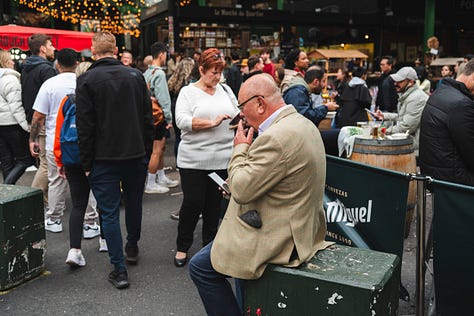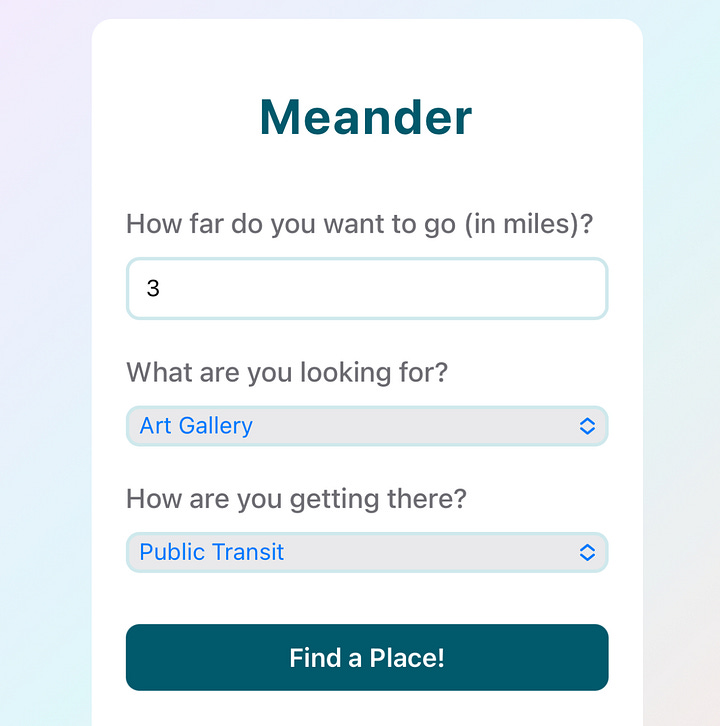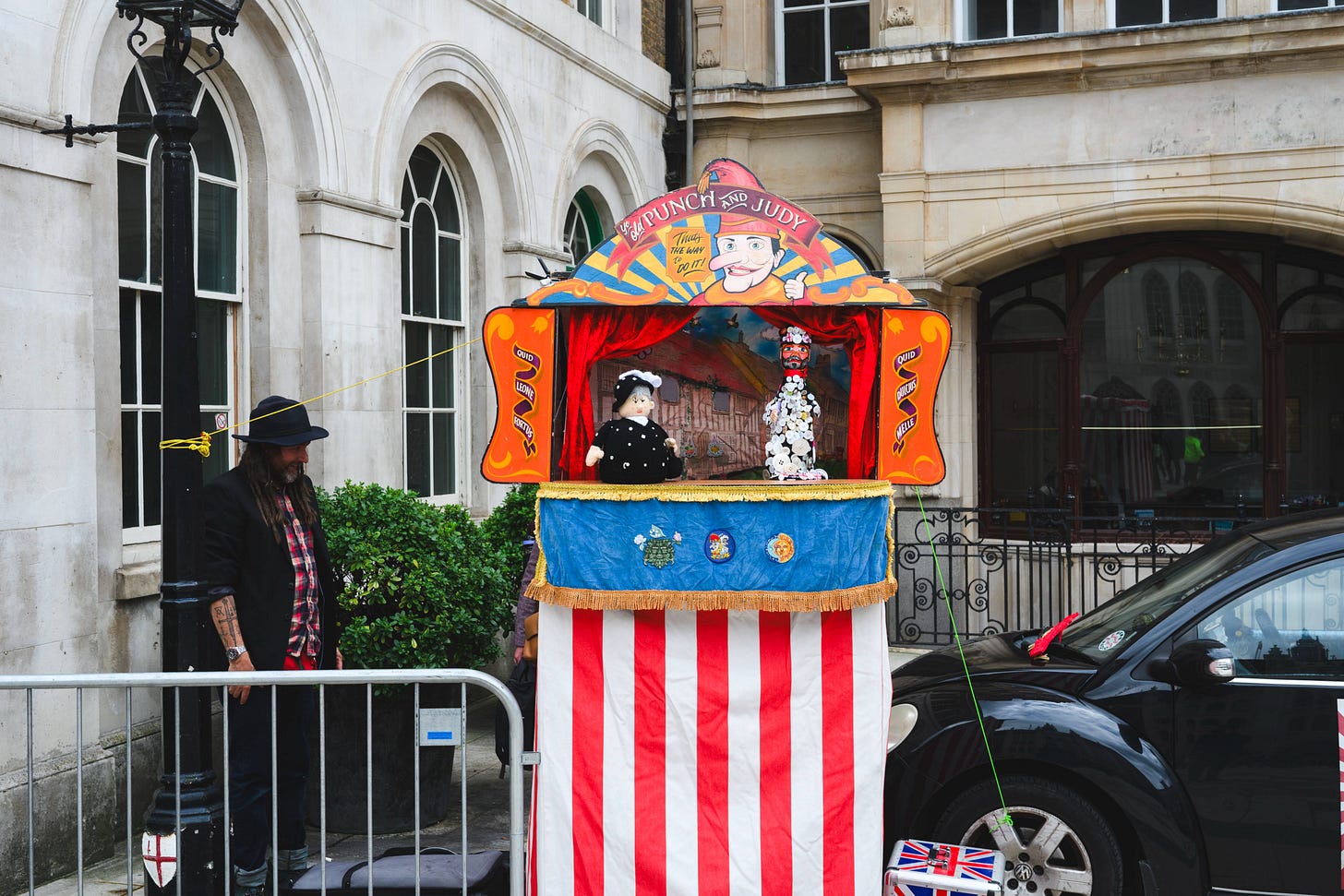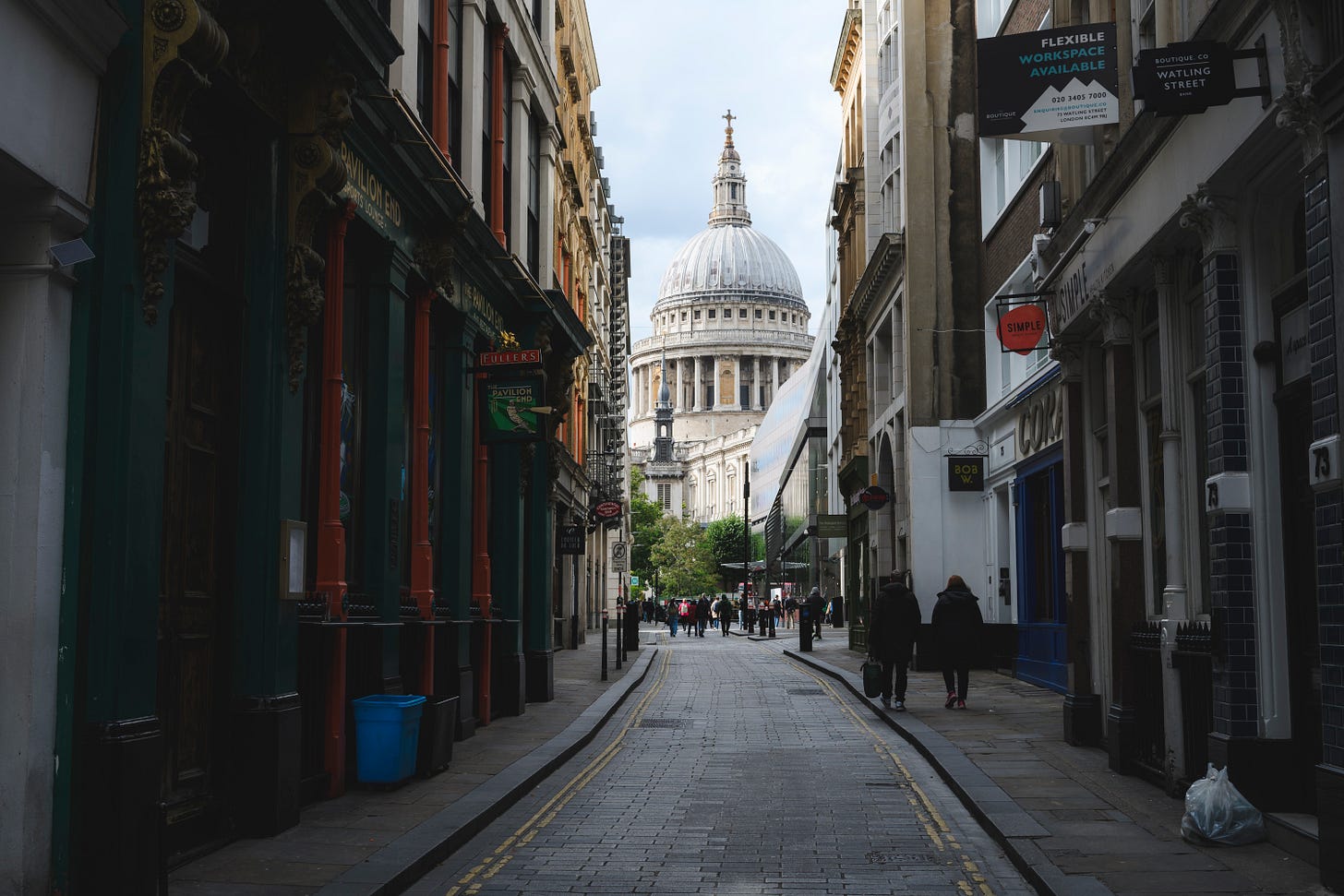I love London. Granted, I love most places, but London especially so. It's a city I'm familiar enough with to have a routine, spots I like to eat and drink, and neighborhoods to linger in, if not purely out of habit and nostalgia. And yet I hardly know the place at all. London is an endless city and it would be foolish to ever claim to be some kind of authority. But that's part of what makes it so intoxicating.
Coming off the heels of our walk through Yorkshire, I had a few nights to kill in London before heading to Munich. This time around, I figured I'd experiment a bit.
A few months ago, I came by the concept of the dérive, or "the drift." It's a technique that calls for "rapid passage through varied ambiences," to study the psychogeography of a place - how does the geography and environment affect our emotions and behavior? The dérive popularized by Guy Debord and the Situationist International (SI), an avant-garde collective of artists based in Paris from 1957-72.
According to Debord, cities are designed to funnel us towards certain areas and away from others. In his essay, the Theory of the Dérive, Debord puts it this way -
…from a dérive point of view cities have psychogeographical contours, with constant currents, fixed points, and vortexes that strongly discourage entry into or exit from certain zones.
The goal then, of the dérive, is to study and pay attention to those contours and learn to subvert them. In the text, Debord also describes his best practices for a dérive and what one might look like. He and other SI members would often follow a random itinerary, take taxis in a specific direction for an arbitrary amount of time, and set up "possible rendezvous" with other dérivers.
In a dérive one or more persons during a certain period drop their relations, their work and leisure activities, and all their other usual motives for movement and action, and let themselves be drawn by the attractions of the terrain and the encounters they find there.
This all sounded familiar, like a cousin of the ethos I’d been developing for the last few years. My own theory is that, from a traveler’s perspective, we encounter similar contours, both online and in-person, that co-opt and homogenize our experiences. We need more randomness to disrupt our suitcase algorithms and inject more serendipity. And, honestly, to just have some fun.
But how, exactly? Throw a dart at a map? Just start walking and see what I come across? Or maybe take a page out of Lisa Abend’s book and go fully unplugged.
I liked the concept of the dérive but wanted to add my own perspective to it. When I'm on the road, I often find myself wanting something - maybe a restaurant or a bar, or even a museum, but don't want it influenced by any kind of reviews, lists, or recommendation engines. My version of a dérive would be somewhere between intentionality and complete randomness.
So I built myself an app.
I'm not an engineer by any stretch, but I'm dangerous with some documentation to cobble together...something, at least.
The app is pretty simple: enter in a type of destination, a distance, and a form of transit. Once you submit, it'll ask to detect your location, and within a second a new link will appear below that says "Take Me There." Clicking that link will open Google Maps with the coordinates of the location it found and directions using the transit modality you chose.
A few notes. I'm using Google's data, so however Google classifies the place, whether correctly or incorrectly, is how it'll get classified here. Second, the distance input is a radius so it’ll find somewhere in any direction within the given distance. In the future I'd like to add some kind of cardinal directionality. Third, I built it to specifically avoid seeing any information about the destination. No names, reviews, or any other data upfront that could affect my opinions - I want as much surprise as possible.
On a beautiful fall morning in London, I thought it would be a good time to try this out. First up, I figured a "Tourist Attraction" one mile away was a good place to start.


From Shoreditch, the route took me through what felt like the center of corporate London. The streets were lined with large glass office buildings and sterile-looking apartment complexes. It was a Sunday, so empty offices meant empty sidewalks. There was some construction happening, but other than a few workers, the streets were eerily quiet. Between all the new construction, you could pick out the remnants of an older London, trying to hang on, but very much forgotten.




The cashier-less Amazon Fresh felt fitting for the area.
After a few blocks of eerily quiet streets, my ears perked up. Do I hear music? It was faint, so I couldn't quite make it out, but I decided to investigate. Another block closer and the music started to get a little louder - a fiddle? An accordion maybe? It sounded like some kind of dancy folk music.
As I turned a corner, I found a decent-sized crowd standing in a circle, some clapping along with the music and others with their phones pointed towards another group of people in the middle. Between the crowd, I could see people moving in a counterclockwise direction around some kind of pole. They were dressed in red and black robes, but they weren't just any robes, they looked extra...bedazzled? After looking around, I could tell the crowd was generally older, especially those in robes, with a handful of younger kids by their side.
Every few minutes, the music would stop, and one lady in the middle, dressed in a bright pastel dress, would run around the circle and talk to the crowd. She was clearly important and seemed like the head honcho of this bizarre royal English clown festival.
I sat there for a minute trying to decipher what I was watching. Eventually, I caved and asked someone next to me, to which they responded with a matter-of-fact "the Pearly Kings and Queens." Of course, I thought to myself.
After a few minutes of, whatever the hell that was, I decided to move on. I looked at Google Maps to get my bearings and continued on my initial route. A couple of blocks later I made it to my presumed destination - St Mary-le-Bow Church.
Sadly, they were in the middle of preparing for an afternoon service, so I couldn't go inside. Unfortunate, but I wasn't pretending to be too sad about missing out on a church. But hey, randomness was what I was after. At this point, I could've plugged in another destination in my app, but more life was appearing on the streets, so I decided to explore the area.
Then, suddenly, I saw more people in robes. Quite a few, actually. What the hell is with all the robes? I had to follow. In another handful of blocks I was led to some kind of religious-sounding farmer's market. Up and down the street were different stalls, people in robes, and people not in robes but still dressed dapperly. I walked the street and read their signs - "The Worshipful Company of Woolmen" one read, "The Worshipful Company of Bakers" and even "The Worshipful Company of Wheelwrights."



There was also this man shearing a sheep.
Following the market to its end took me to the Southwark Bridge. I checked the map again and saw I was near-ish to Borough Market. I knew Borough Market, so it wasn’t a random stop at all, but I was eager for more photography and people-watching opportunities. I made my way over there and spent a few hours walking the market and the surrounding streets. I had a pleasant time, but it was definitely the least interesting. In hindsight, this was probably one of those physical and psychological “contours” followed out of familiarity or some kind of inertia guiding me.






On one side street near the market I passed by a pub, The Gladstone Arms, and heard some music and singing, so I ducked inside. It was a small pub, nearly full, and nearly every seat was pointed toward the entertainment. In one corner of the pub was a man and woman singing and playing the keyboard - the Variety Bunker singalong, according to their sign. I ordered a beer and stood near the bar, watching for a few songs. They played some old hits like Don’t Stop Believin’ and a couple of unrecognizable but very English sounding songs.
Each song, all the pub goers would join in and sing along or even stand up and dance. There was a familiarity to the whole thing, clearly everyone knew everyone in the pub and this was a semi-regular happening at The Gladstone Arms.
The next morning I realized that, for all the random events of the previous day, I had actually only used my app once. I didn't even use it to find food or drink, which is typically my raison d'être. Though all the meandering was in the spirit of drifting and following whatever curiosity I found, I still felt like I needed more. So, I opened up my app and searched for a bakery.


This time it sent me in the opposite direction, north of where I was staying. It was around 9 am on a Monday, so the city was more alive with car and foot traffic. The route was taking me against the grain of the commuters, which I took as a good sign.
Along the way I passed by an assortment of older apartment complexes, a community center, an old internet cafe, quite a few cosmetics shops, discount stores, some art galleries, and plenty of bars/cafes. An eclectic mix, but one that pretty clearly meant this part of Shoreditch/Hoxton was somewhere along the gentrification spectrum.
Eventually, I made it to Humdinger's, which according to Google Maps was a caterer, breakfast spot, and also a food kitchen? Either way, it was also very closed, so no luck. But a few minutes prior, I passed by a cafe that looked promising, so I decided to double back and check it out.
Paula's Cafe had all the signs of a good greasy spoon - an old weathered red awning with gold lettering that promised coffee and breakfast. Outside were a handful of city workers in high-viz gear, sitting with their coffee and breakfast under the awning. The cafe was small and simple, fewer than 10 tables. Near the back was a glass deli counter with a large menu hanging above it.
From what I could tell, there were about 15 different iterations of a typical English breakfast on the menu. My eyes glazed looking at all the options, but in a short few seconds a woman came over to take my order. I pointed to one that had black pudding and eggs - I knew I'd be happy. And coffee, of course.
At the table in front of me, there were two middle-aged men sitting diagonal from one another. One was reading the paper and the other scrolling his phone. Occasionally they'd look up and say a few words, then go back to their business. It was a routine for them, maybe even a daily one. I watched for a few minutes, sipping my coffee until my breakfast was ready.
You might be inclined to balk at this plate, but if you feel like your palate is too refined for this, you’re wrong. Three hefty slices of black pudding, two slices of bacon (I'm a floppy bacon kinda guy, sue me), two eggs, and toast. All this and a cup of coffee for under 8 pounds. There was nothing glamorous about Paula’s. Nothing that will bring the foodies to roost. But is that so bad? Too often the food and travel circles have more in common with trophy hunting than anything else.
While I was finishing up, a man came over and asked how everything was and where I was from - he was giving owner energy. I thanked him and said the food was great. He chuckled, adding that it's hard to find places like this anymore. I asked why, and with two hands gesturing to the general area, he said "the city is changing." We continued talking briefly for a few minutes before I left.
Outside of Paula’s I opened up the app. Next up, an art gallery somewhere in Covent Garden.


So, after my London dérive, what do I know? Can I claim to know the city now? Of course not. Though admittedly I was surprised by the amount of community I found in such a small sliver of London. It was the type of community that I wouldn’t have found scouring through curated guides or resources. And I also know where to get a hell of a breakfast.
As far as my app experiment goes, I’d say it was a mostly successful trial. By far the most interesting moments during my time in London happened when I used it, either the destination itself or whatever happened along the way. Of course you don’t need an app to do any of this, you could easily just pick a direction and go into random storefronts along the way. But having some general objective helps break through some of those psychogeographical contours.
As always, thanks for reading.
- Skylar














Love the Meander App idea - I think you are on to something here. The amount of time we waste researching an itinerary or where to get something ultra delicious, I'd rather not think about it. Sometimes you just need a good nudge in a direction and low expectations! Haven't had an English breakfast in way too long mmm...
That is a great article! And a pleasure to read. Thank you.